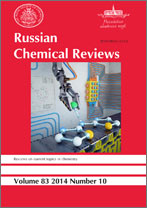|
Coordination Chemistry in Italy: The Work of the Rome School
C. Furlaniab
a University of Rome, Institute of General and Inorganic Chemistry, Italy
b Laboratory of Coordination Compounds National Research Council of Italy
Abstract:
The principal directions of the development of coordination chemistry in Italy (the Rome school) are considered in their historical aspect. In the field of the theory of the structure of complex compounds research on the ligand field theory and calculations by the molecular orbital methods are being carried out in Rome. Numerous studies on the synthesis and determination of the structures of many new complexes are examined and the kinetics and mechanisms of chemical reactions of coordination compounds, mainly substitution reactions, are discussed. Much attention is devoted to the investigation of the properties of complexes with the aid of various physical methods — electronic and photoelectron spectroscopy, vibrational spectroscopy, magnetic resonance methods (EPR, NMR, NQR), and electrochemical methods (particular polarography). Studies related to the preparation of catalytically active complexes and their properties are also considered.
The bibliography includes 247 references.
Citation:
C. Furlani, “Coordination Chemistry in Italy: The Work of the Rome School”, Usp. Khim., 47:10 (1978), 1756–1773; Russian Chem. Reviews, 47:10 (1978), 944–954
Linking options:
https://www.mathnet.ru/eng/rcr3088https://doi.org/10.1070/RC1978v047n10ABEH002286 https://www.mathnet.ru/eng/rcr/v47/i10/p1756
|


| Statistics & downloads: |
| Abstract page: | 95 |
|





 Contact us:
Contact us: Terms of Use
Terms of Use
 Registration to the website
Registration to the website Logotypes
Logotypes









